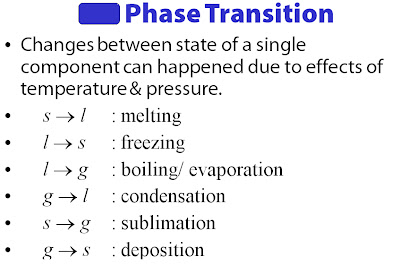All matters exists in one of three states -- Solid, Liquid or Gas. The following characterizes the three states:
Solid
- The greatest forces of attraction are between the particles in a solid and they pack together in a neat and ordered arrangement.
- The particles are too strongly held together to allow movement from place to place but the particles vibrate about there position in the structure.
- With increase in temperature, the particles vibrate faster and more strongly as they gain kinetic energy.
- Solids have the greatest density (heaviest) because the particles are closest together.
- Solids cannot flow freely like gases or liquids because the particles are strongly held in fixed positions.
- Solids have fixed surface and volume (at a particular temperature) because of the strong particle attraction.
- Solids are extremely difficult to compress because there is no real “empty” space between the particles.
- Solids will expand a little on heating but nothing like as much as liquids because of the greater particle attraction restricting the expansion (contract on cooling). The expansion is caused by the increased strength of particle vibration.
- Liquids have a much greater density than gases (heavier) because the particles are much closer together.
- Liquids flow freely despite the forces of attraction between the particles but liquids are not as fluid as gases.
- Liquids have a surface, and a fixed volume (at a particular temperature) because of the increased particle attraction, but the shape is not fixed and is merely that of the container itself.
- Liquids are not readily compressed because of the lack of empty space between the particles.
- Liquids will expand on heating (contract on cooling) but nothing like as much as gases because of the greater particle attraction restricting the expansion.
- When heated, the liquid particles gain kinetic energy and hit the sides of the container more frequently, and more significantly, they hit with a greater force,so in a sealed container the pressure produced can be considerable.
- Gases have a low density (light) because the particles are so spaced out in the container (density = Mass ÷Volume).
- Gases flow freely because there are no effective forces of attraction between the particles.
- Gases have no surface, and no fixed shape or volume, and because of lack of particle attraction, they spread out and fill any container.
- Gases are readily compressed because of the empty space between the particles.
- If the container volume can change, gases readily expand on heating because of the lack of particle attraction, and readily contract on cooling. On heating, gas particles gain kinetic energy and hit the sides of the container more frequently, and more significantly, they hit with a greater force. Depending on the container situation, either or both of the pressure or volume will increase (reverse on
cooling). - The natural rapid and random movement of the particles means that gases readily spread or diffuse. Diffusion is fastest in gases where there is more space for them to move and the rate of diffusion increases with increase temperature.


http://formulaluarbiasa.com/recommends/moneysecret
ReplyDelete